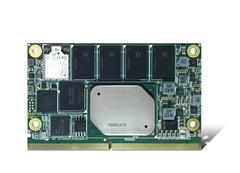congatec further standardizes interface setup for SMARC 2.0
 Our partner congatec – a leading technology company for embedded computer modules, single board computers and embedded design and manufacturing services – introduces new SMARC 2.0 modules supporting powerful USB C connectivity at Embedded World (hall 1, stand 358) today. The utilization of the USB-C specification makes USB interconnects even more universally applicable, further standardizing the interface setup of SMARC 2.0 based embedded devices. System designers can use USB C for standard peripherals from USB 3.1 to USB 1.0 and – a brand new option – for connecting displays or even the power supply to the system or peripheral devices, reducing cabling efforts to a single cable. In addition, the current data throughput of up to 5 Gigabit/s in line with the USB 3.1 specification serves as a turbo charger for data intensive applications. Based on Intel® Atom™, Celeron® or Pentium® processors (codename Apollo Lake), typical applications for SMARC 2.0 designs are handhelds and other mobile devices, in-vehicle devices and stationary embedded and IoT systems with low power and high performance demands.
Our partner congatec – a leading technology company for embedded computer modules, single board computers and embedded design and manufacturing services – introduces new SMARC 2.0 modules supporting powerful USB C connectivity at Embedded World (hall 1, stand 358) today. The utilization of the USB-C specification makes USB interconnects even more universally applicable, further standardizing the interface setup of SMARC 2.0 based embedded devices. System designers can use USB C for standard peripherals from USB 3.1 to USB 1.0 and – a brand new option – for connecting displays or even the power supply to the system or peripheral devices, reducing cabling efforts to a single cable. In addition, the current data throughput of up to 5 Gigabit/s in line with the USB 3.1 specification serves as a turbo charger for data intensive applications. Based on Intel® Atom™, Celeron® or Pentium® processors (codename Apollo Lake), typical applications for SMARC 2.0 designs are handhelds and other mobile devices, in-vehicle devices and stationary embedded and IoT systems with low power and high performance demands.
The application ready best practice design-in of recent USB-C capabilities is shown on congatec’s SMARC 2.0 modules with latest Intel® Atom™, Celeron® and Pentium® processors and a suitable carrier board with one fully featured onboard USB-C jack for demonstrating the new power supply capabilities as well as the display integration.
The feature set in detail
congatec initially implements USB-C on its new conga-SA5 SMARC 2.0 Computer-on-Module and the new evaluation carrier board conga-SEVAL. The comprehensive USB-C functionalities include USB 2.0, USB 3.1 Gen 1 support with data rates of up to 5 Gigabit/s and the alternate modes for Display Port 1.2 (DP-Alt) and USB Power Delivery (USB-PD) supporting a power envelope of up to 100 W. All signals are simultaneously present at the point-symmetric female USB-C connector with 24 signal pins. For the power modes, the solution supports all USB-PD modes as specified by the Universal Serial Bus Implementers Forum (USB-IF). Besides the USB 3.0 compliant mode with 5 V and 1.5 A, it can provide additional voltages of 12 V and 15 V with a maximum current of 3 A and also 20 V with 5 A maximum current. Thanks to this, USB-C becomes also a unifying power supply standard for both peripheral devices and systems. OEMs and developers can use congatec’s new SMARC module and carrier board as an application ready design-in solution for off-the-shelf evaluation of this new technology. To further simplify the development of custom specific USB-C implementations, congatec also delivers all required circuit diagrams upon request and for OEM customers only. Alternatively, OEMs can leverage congatec’s EDM services to have their specific solution designed for them to reduce in-house development efforts and time to market to a minimum. Furthermore, congatec is working on USB-C implementations on its Qseven and COM Express Computer-on-Modules, maximizing USB connectivity to data rates of up to 40 Gigabit/s via Thunderbolt 3 for powerful COM Express Type 6 designs.
